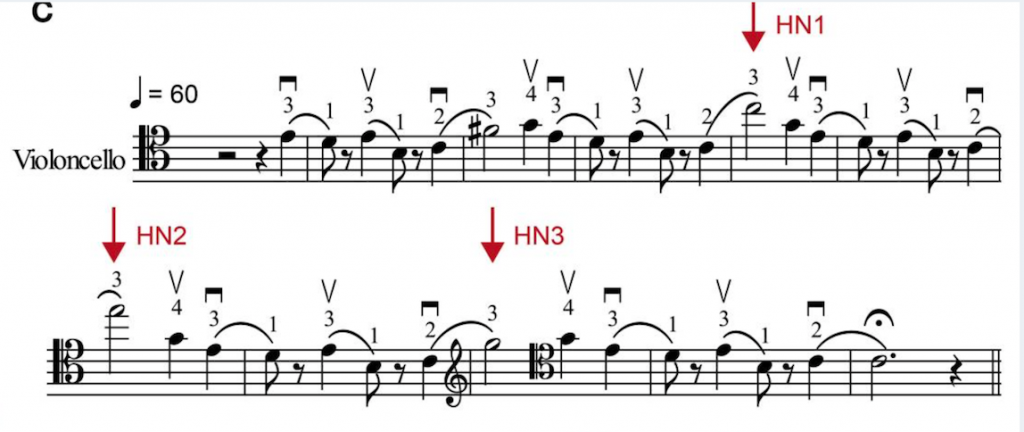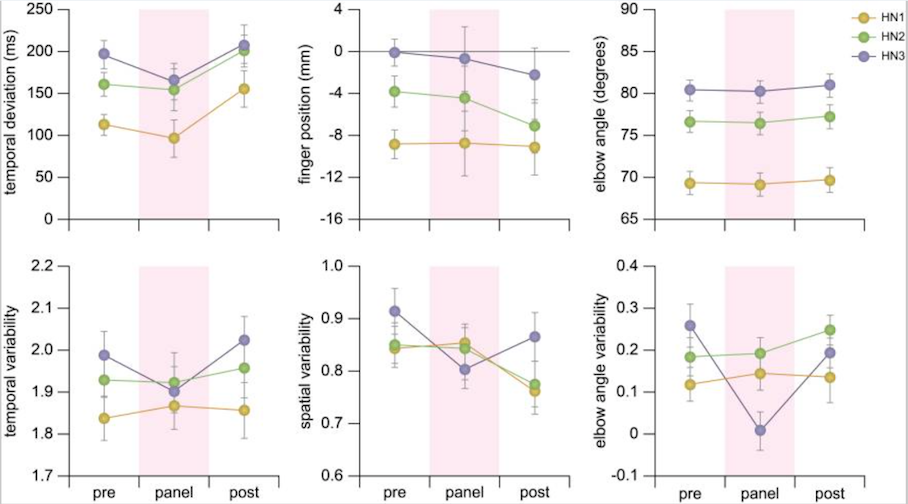Title of paper under discussion
Interaction between physiological and subjective states predicts the effect of a judging panel on the postures of cellists in performance
Authors
Satoshi Endo, Kristina Juhlberg, Adrian Bradbury and Alan M. Wing
Journal
Frontiers in psychology vol. 5 773. (2014)
Link to original paper (open access)
Overview
24 cellists each played a short excerpt of music, both alone and in front of a panel, with scientists investigating how the presence of the panel affected three aspects of their beings: behaviour (by measuring left elbow angle), physiology (heart rate) and subjective state (feelings of anxiety). Among other findings the scientists showed that as the cellists’ heart rates rose, those who felt anxious saw their left elbows close, while those who felt relaxed saw them open.
Music Performance Anxiety (MPA)
MPA, like any emotion, comprises three elements – mental (feelings), physiological and behavioural. In carrying out a review of the literature on MPA before the experiment, the scientists discovered plenty of research into the mental and physiological manifestations of MPA, but not so much into the behavioural ones. Such behavioural research always concentrated on how well motor tasks were completed under stress, rather than measuring the movements employed to effect those tasks. In the present study, through the use of a motion tracking system monitoring the elbow angle and finger movements of a cellist during performance under stress, the behavioural aspect of MPA was being measured as a variable for the first time.
Method
This study was based entirely on performances of a short excerpt of music, adapted from Brahms Double Concerto op 102 and containing three “high notes” (HN1, HN2, HN3).

Each cellist played the piece (along to a metronome of 60 bpm) fifteen times : 1) five times in a room with just the technician present (“pre-panel condition”) 2) five times in front of a panel of three ‘adjudicators’, with a red light to mimic a ‘live recording’ situation (“panel condition”) and 3) five more times after the panel had left the room and the red light was turned off (“post-panel condition”). The ‘panel condition” was so designed to elicit musical performance anxiety.
The mental, physiological and behavioural states of the players were monitored, especially at and around the execution of the high notes (HN1, HN2, HN3 – see musical excerpt above). A six-camera motion tracking system, recording movements of reflective markers fixed to the player’s limbs and cello, collected behavioural (left hand 3rd finger position and left elbow angle) data. A pulse pressure monitor (measuring heart rate) and surface electrodes (measuring sweat activity) collected physiological data. Mental state before and after each trial was assessed using a questionnaire asking how stressed the cellist felt on a scale of 1 (‘completely relaxed’) to 7 (‘unbearably anxious’).
A 10 second CGI video, showing the heart rate, sweat and movement data from one of the players, is displayed here (explanation under the video).
Results
Mental state
Being in front of the panel did, as expected, affect a cellist’s mental state, making them feel under more pressure as evidenced by their answers to the “how anxious do you feel?” questionnaire.
Physiological state
Although instantaneous readings of sweat were challenging to deduce because of its accumulation on the cellists’ fingers as the experiment progressed, it was clear that the players sweated more in front of the panel, and that each high note itself brought on a surge of sweating. Heart rate too was highest in front of the panel, with the highest ‘high notes’ bringing on the fastest pace.
Behavioural state
The authors consider three behavioural states in turn: 1) the timing of the high notes in relation to the metronome 2) the position of the high notes compared with ‘correct’ positions of the notes determined by the player before the experiment 3) the left elbow angle during the high notes.
These behavioural data are presented in Figure 4 (see below) of the paper, with the finger timing, finger position and elbow angle measurements comprising the top row of graphs, and their respective variabilities underneath. (Variability represents how wide the spread of those particular data was between different players and their different trials; in other words, variability is the opposite of consistency). In the graphs, data taken during high note 1 (‘HN1’ in the musical excerpt above) is always in yellow, high note 2 (HN2) in green and high note 3 (HN3) in purple. The “pre, panel and post” conditions refer, respectively, to the cellist before the panel entered the room, while the panel was present, and after the panel had left.

Notice that:
- [left graphs, top and bottom] The timing of the ‘high notes’ (HN1, HN2, HN3) was generally more accurate and less variable (more consistent) in front of the panel than without a panel present
- [middle graph, top] The cellists generally undershot the shifts up to the high notes – HN1 by about 9mm, HN2 by 4-8mm and HN3 from 0-2mm – especially once the panel had left the room. The fact that the highest ‘high note’ was consistently the most accurately positioned reflects the need to hit an ever smaller ‘target window’ as a cellist climbs the fingerboard (just as the frets of a guitar get closer together the nearer you get to the bridge).
- [right graphs, top and bottom] The left elbow seems most flexed in front of the panel, but by so little the result isn’t quite statistically significant. The left elbow angle is, though, most consistent (least variable) when the panel was present.
Interaction between mental, physiological and behavioural states
“Interaction” is the term used in statistics when the effect of one variable (e.g. heart rate) on another (e.g. elbow angle) depends on a third variable (e.g. mental state).
In the headline finding to come out of this study, an interaction was indeed found – between heart rate and mental state on left elbow angle.
Three of the players had a positive, less stressed outlook during the panel condition – and their elbows tended to open up the higher their heart rate.
In contrast seventeen of the players felt more stressed in front of the panel, and their elbows tended to be more flexed the higher their heart rate.
Discussion
As well as noting that cellists tended to shift more slowly up to top notes in order to achieve greater positional accuracy (tuning), the authors also mention that a slightly more flexed left elbow in the presence of a panel (though not significant) may reflect frightened ‘avoidance behaviour’ in the presence of ‘danger’ (limb retraction and ‘freezing’).
Readers are reminded that a high heart rate and increased sweat, though indicative of arousal (‘a state of heightened physiological activity’), do not necessarily signify anxiety. Reference is made to previous research outlining that a modicum of such arousal can improve performance, and to this present research showing that such arousal coupled with a positive outlook leads to a more open elbow, in turn helping to reach high notes on the cello. With this in mind the authors argue that the concept of performance arousal, as distinct from performance anxiety, should enter the musical lexicon – if only to remind players that with the right mental attitude, adrenalin can be their friend.
Coda
Brahms Double Concerto, op.102
Violin – David Oistrakh, cello – Mstislav Rostropovich